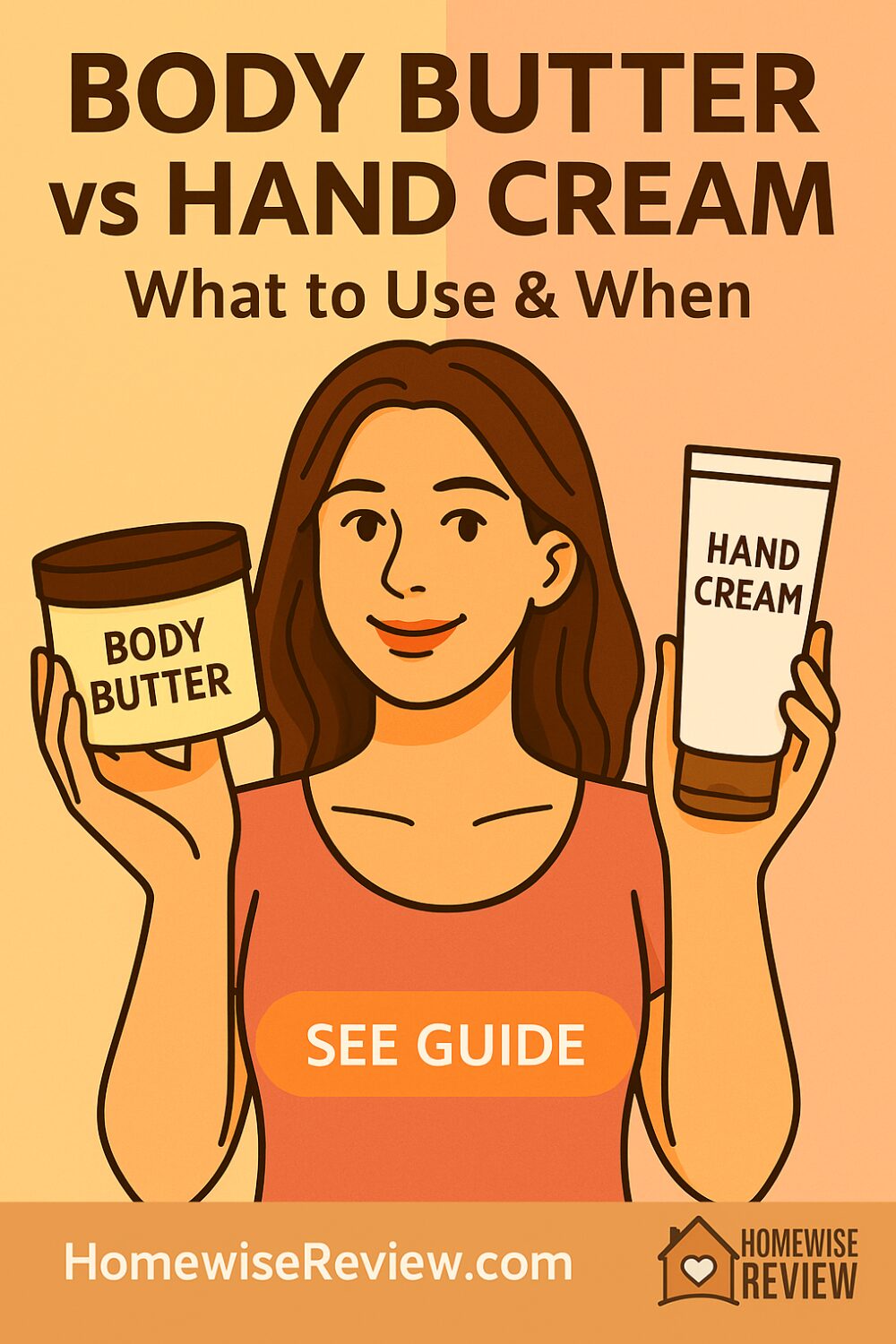Provides hours of rich hydration that soothes dry legs and elbows with a classic creamy shea formula.

Dry hands and tight, itchy skin can feel the same, but the products that fix them are not identical. Body butter and hand cream are both moisturizers, yet they are built for different jobs. Body butter is a thicker, occlusive-rich formula that seals in moisture on large areas like legs, arms, and torso. Hand cream is a compact, fast-absorbing formula that targets frequent washing, cold air, and daily wear on the hands without leaving a greasy film.
This guide explains the real differences in texture, ingredients, and results. You will see when to choose each one, how to layer them with other products, and what to try from Amazon. There is a full FAQ, a short routine, and a wrap up at the end. We never make fake hands-on claims. These picks come from brand info and consistent owner feedback.
Quick answer
- Use body butter when your arms, legs, belly, or back feel tight, flaky, or ashy. It is best after showering and at night.
- Use hand cream throughout the day after washing or sanitizing. It sinks in faster and protects without leaving keyboards and phones oily.
- You can use both. Body butter for big areas, hand cream for palms and knuckles.
How they differ
Texture and finish
- Body butter: Very rich. Thick balm or dense cream. Leaves a protective film that reduces water loss. Finish can be dewy or slightly glossy.
- Hand cream: Medium to rich. Designed to absorb quickly and leave a dry-touch finish so you can drive, type, and cook.
Core ingredients
- Body butter usually loads up on occlusives and emollients
- Shea butter, cocoa butter, mango butter
- Petrolatum, mineral oil, dimethicone
- Plant oils like coconut, jojoba, squalane
- Hand cream balances barrier repair with slip control
- Humectants like glycerin and hyaluronic acid
- Barrier lipids like ceramides
- Film formers like dimethicone to protect from water and soap
Best use cases
- Body butter: Post-shower on damp skin, overnight masking on elbows or heels, winter protection under clothing.
- Hand cream: Every time you wash dishes or use sanitizer, before heading outside in cold weather, before bed on cuticles and knuckles.
Seasonality
- Warm months or humid climates: hand cream by day, a light body lotion on limbs.
- Cold or dry months: hand cream in your bag and a body butter jar by the shower.
How to choose
- Skin type
- Very dry or ashy body skin: choose a body butter with shea or petrolatum.
- Hands that crack or sting: pick a fragrance-free hand cream with glycerin and dimethicone.
- Scent sensitivity
- Use fragrance-free for eczema-prone or cracked skin. Add scented products only when skin is healthy.
- Lifestyle
- Desk work and phones: dry-touch hand creams win.
- Overnight recovery: thicker body butters or ointment occlusives give the best results.
How to use them together
- After shower: Pat skin so it is damp, then apply body butter on arms and legs.
- Daily hand care: Apply hand cream after handwashing and before going outside.
- Spot treat: For cracked knuckles or heels, layer a thin petrolatum ointment on top at night and wear cotton gloves or socks.
Best body butters
1) The Body Shop Shea Body Butter
Rating: 4.6/5
Rich, classic shea formula that softens and protects for hours. Great for dry legs and elbows.
Pros: Long lasting comfort, familiar scent options, big tub value.
Cons: Scented versions can bother sensitive skin, heavy for humid days.
2) Sol de Janeiro Brazilian Bum Bum Cream
Rating: 4.5/5
Fast-absorbing butter-cream with cupuaçu butter and caffeine from guaraná. Less greasy than old-school butters, nice for day use on arms and legs.
Pros: Sinks in quickly, signature fragrance, smoother look on skin surface.
Cons: Premium price, fragrance is strong if you prefer unscented.
3) NIVEA Cocoa Butter Body Cream
Rating: 4.4/5
Affordable tub with cocoa butter and plant oils for deep comfort. A reliable drugstore pick for families.
Pros: Budget friendly, big size, very moisturizing.
Cons: Heavier texture, jar packaging.
Best hand creams
1) Neutrogena Norwegian Formula Hand Cream Fragrance Free
Rating: 4.7/5
Glycerin-rich classic that calms stinging, cracked hands and forms a protective film without greasiness.
Pros: Fragrance free, tiny amount goes far, works in cold weather.
Cons: Balm texture can feel thick if you over apply.
2) L’Occitane Shea Butter Hand Cream
Rating: 4.6/5
Luxurious cream with 20 percent shea butter and soothing oils. Great for bedtime and giftable sets.
Pros: Deeply softening, elegant finish, travel sizes available.
Cons: Scented, cost adds up for daily heavy use.
3) O’Keeffe’s Working Hands Hand Cream
Rating: 4.6/5
High glycerin, fast drying formula that reduces cracking for people who wash or work with hands all day.
Pros: Non-greasy, fragrance free, strong protection for frequent washers.
Cons: Basic feel, not a luxury texture.
Simple routines
Everyday body routine
- Short warm shower, gentle body wash.
- Pat skin so it stays damp.
- Apply body butter to arms, legs, torso.
- Target heels and elbows with an extra pea-size.
Hand routine for frequent washers
- Use a mild soap.
- Pat mostly dry.
- Apply a pea-size hand cream to backs of hands and massage into knuckles and cuticles.
- Before bed add a thin layer of petrolatum on cracks, then cotton gloves.
Wrap up
Body butter and hand cream are both useful, but they solve different problems. Use body butter to seal in moisture on large areas and to soften rough spots. Use hand cream for frequent washing and daily protection that dries down fast. Keep a hand cream in your bag or car, and keep a body butter jar near the shower. With consistent use you will see fewer cracks, less tightness, and softer skin in a week or two.
FAQ
Is body butter better than lotion?
Body butter is thicker and more occlusive. It is better for very dry or flaky areas and overnight use. Lotion is lighter and better in warm weather or for people who dislike any residue.
Can I use body butter as a hand cream?
Yes, but most body butters stay a little tacky on palms. For daytime phone and keyboard use, a dry-touch hand cream is more practical.
Do I need both if I already use a rich moisturizer?
If your hands are still cracking or your shins still look ashy by evening, using both makes sense. Keep hand cream in your bag and a body butter jar by the shower.
What ingredients should I look for if my skin is very sensitive?
Fragrance free, glycerin, petrolatum, dimethicone, shea butter, ceramides. Avoid essential oils and strong plant fragrances until skin is calm.
How often should I apply?
As often as needed. After every hand wash for hand cream and after each shower for body butter. Add a bedtime application if your climate is dry.
See also
If dryness is your top concern, pair this article with our Dry Skin Routine for a morning and night plan, and check Best Foundation for Dry Skin if makeup is settling on flakes. If you want a forgiving base for texture too, see Best Foundation for Large Pores. For mature complexions that need extra comfort, try Best Foundation for Mature Skin Over 60.
We may earn a small referral fee at no extra cost to you.
